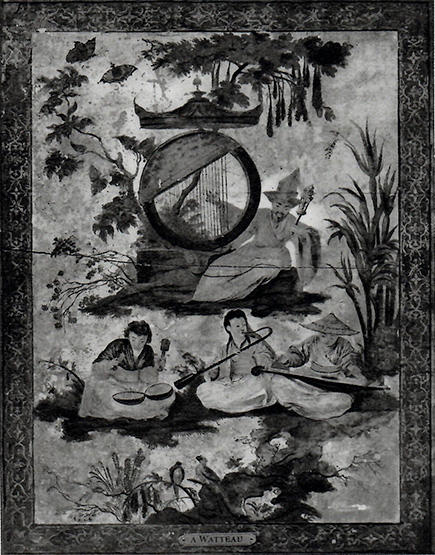
- Home Page
- Accepted
Paintings & Copies - Doubtful
Attributions - Doubtful Textual References
- Alternative
Titles - Collectors &
Museums - Bibliography
- Search Abecedario
- Watteau &
His Circle
X. Les Musiciens chinois
Entered May 2023

Whereabouts unknown
Oil on panel
74.5 x 57 cm
ALTERNATIVE TITLES
Composition with Oriental Figures
Chinoiserie
Composizione con personaggi cinesi
PROVENANCE
Paris, collection of Daniel Saint (1778-1847; miniaturist). His sale, Paris, Hôtel des ventes, May 4-7, 1846, lot 66 bis: “DU MÊME [WATTEAU (Antoine)] . . . Divers sujets, pastorales, danses costumes, scènes chinoises; ces divers objets ont été peintes par Watteau, sur fond d’or, sur les panneaux d’un clavecin, provenant d’une maison royale.” Sold for 1,051 francs to “Varneck.”
.
Paris, collection of Georges Edouard Warneck (1834-1924; art collector and dealer). His sale, Paris, Galerie Georges Petit, May 27-28, 1926, lot 94: “ÉCOLE FRANÇAISE XVIIIe siècle. . . . Les Musiciens chinois. Panneau décoratif. Dans une bordure d’arabesques, sur un fond d’or, un Chinois, en costume rouge et jaune, pince d’une sorte de harpe forme circulaire. Il accompagne deux femmes et un jeune homme assis plus bas, jouant des timbales, du hautbois et de la guitare. Bois. Haut. 74,5 cent.; large., 57 cent.” According to an annotated copy of the sale catalogue in the Watson Library, Metropolitan Museum of Art, New York, the picture sold for 20,500 francs to "Wagner de Besançon.”Paris, collection of Ernest and Marguerite Besançon de Wagner.
SELECT BIBLIOGRAPHY
Adhémar, Watteau (1950), cat. 21 b.
Macchia and Montagni, L’opera completa di Watteau (1968), cat. 29 C.
REMARKS
When this panel and other chinoiserie subjects were in Daniel Saint’s collection, they were grouped in one lot and were sold as coming from harpsichord that formerly had been in a royal house. Whether this was Saint’s or the auctioneer’s tale, the claim was a Romantic era fantasy. The panels were executed by different hands and came from more than one source. Nonetheless, elements of this tale survived into the twentieth century. Adhémar wrongly claimed that this panel came from a harpsichord executed in vernis Martin. However, the rectangular shape of this panel does not reflect the structural norms of a harpsichord. More likely it was a section of wall paneling. Moreover, vernis Martin was not invented until c. 1730, a decade after Watteau’s death. Our artist would have used Audran’s vernis de Gobelins. But since there is no indication that Watteau executed this panel, it may well be in vernis Martin or one of the other French alternative lacquers.
Unlike many of the other panels from Saint’s sale, this one is more Eastern in style and subject. Its two-dimensional spatial arrangement, the portrayal of actual Eastern musical instruments, costumes, and flora follow Eastern traditions more than most of the other works in the lot sold from Saint’s collection.
Macchia and Montagni recorded the painting’s dimensions as 26.5 x 149, but this does not correspond to the somewhat square shape of the panel. Modern Watteau scholars do not discuss the painting, much less accept the attribution.